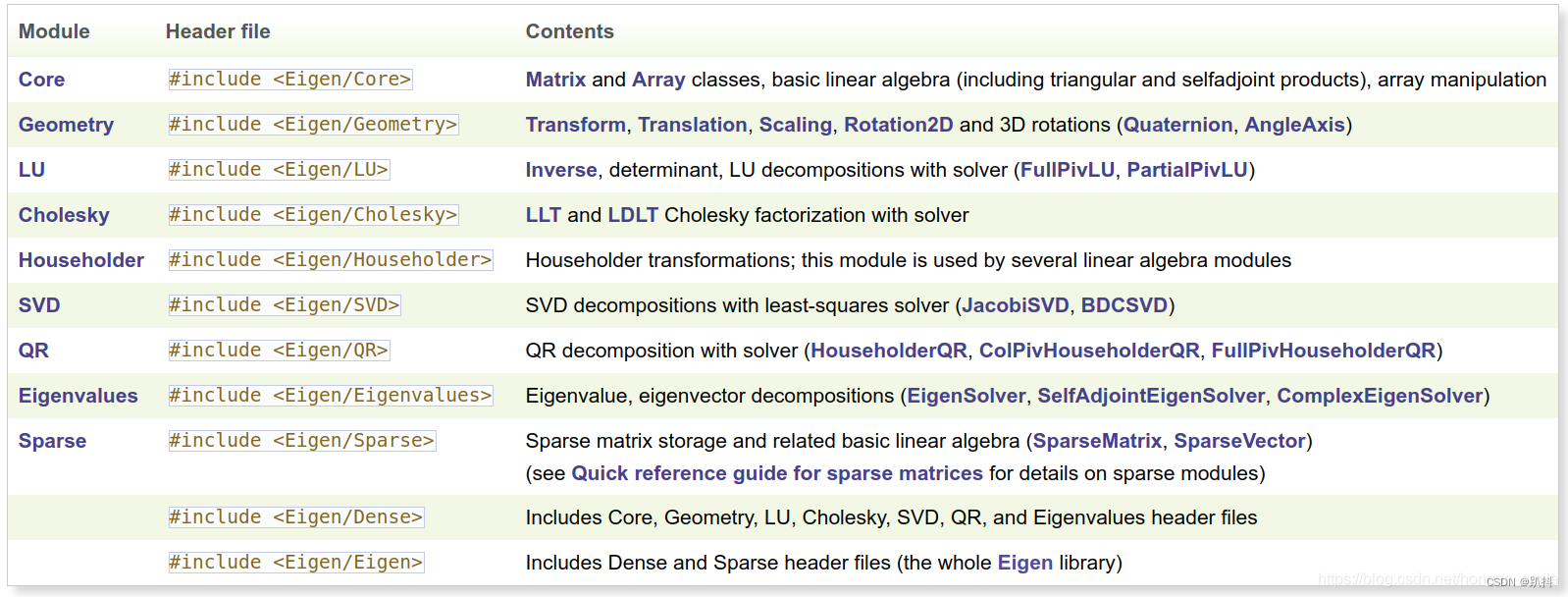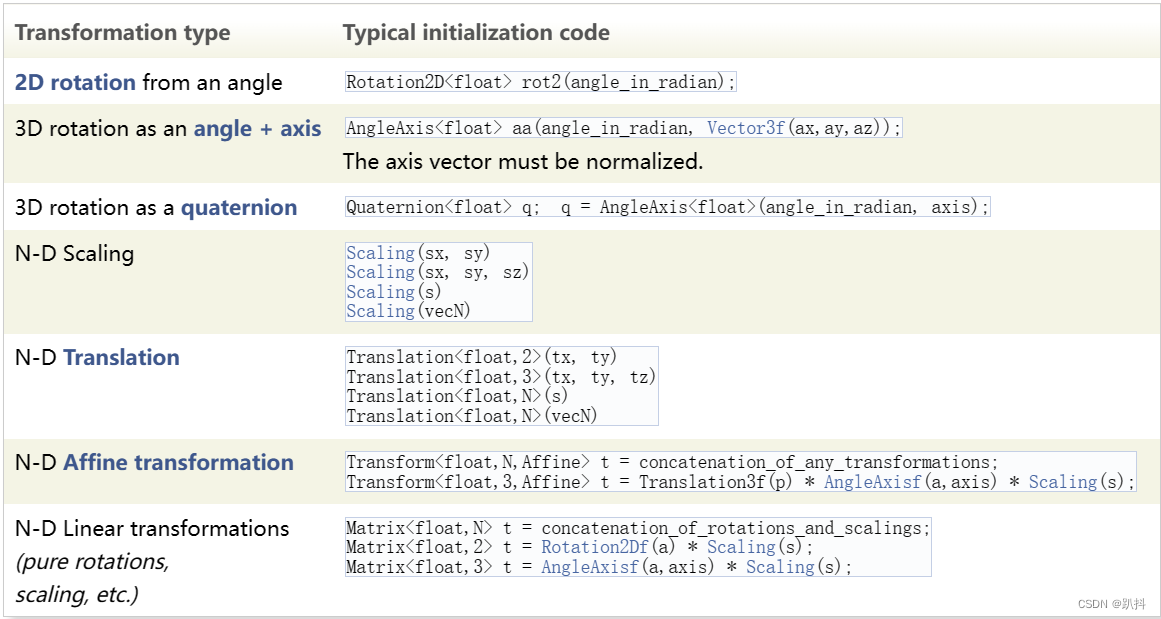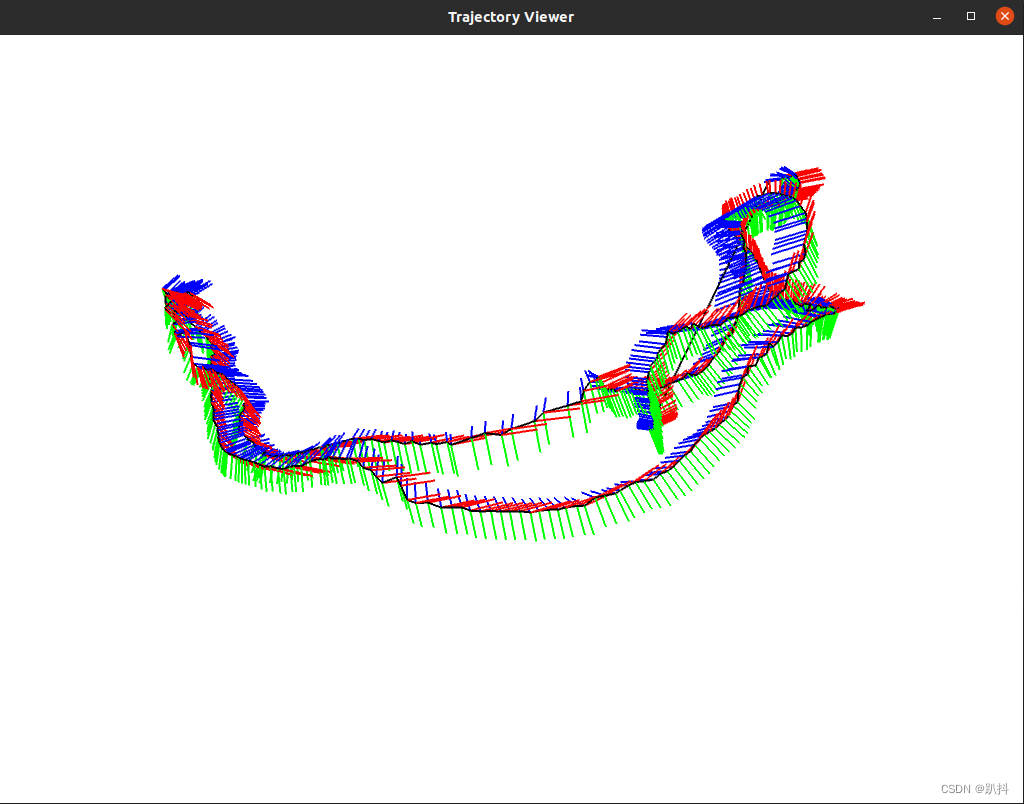专栏系列文章如下:
【视觉SLAM十四讲学习笔记】第一讲——SLAM介绍
【视觉SLAM十四讲学习笔记】第二讲——初识SLAM
【视觉SLAM十四讲学习笔记】第三讲——旋转矩阵
【视觉SLAM十四讲学习笔记】第三讲——旋转向量和欧拉角
【视觉SLAM十四讲学习笔记】第三讲——四元数
本章将介绍视觉SLAM的基本问题之一:如何描述刚体在三维空间中的运动?
目录
这一篇文章将原书第三讲中有关Eigen的部分跟官方教程进行了一定程度上的整合。
Eigen简介与安装
安装
Eigen是一个C++开源线性代数库。它提供了快速的有关矩阵的线性代数运算,还包括解方程等功能。许多上层的软件库也使用Eigen进行矩阵运算,包括g2o、Sophus等。
请输入以下命令进行安装:
sudo apt-get install libeigen3-dev
CMakeLists.txt编写
与其他库相比,Eigen的特殊之处在于,它是一个纯用头文件搭建起来的库,这意味着你只能找到它的头文件,而没有类似.so或者.a的二进制文件。在使用时,只需引入Eigen的头文件即可,不需要链接库文件(因为它没有库文件)。用cmake管理项目的时候,只需要在CMakeLists.txt里面头文件的路径即可:
#添加头文件
include_directories("/usr/include/eigen3")
因为Eigen库只有头文件,所以不需要再用target_link_libraries语句将程序链接到库上。
Eigen每个头文件的作用
Eigen所有的头文件及头文件里面的类的作用见下表:

| 模块 | 头文件 | 内容 |
|---|---|---|
| Core | #include <Eigen/Core> | 矩阵和数组类,基本线性代数(包括三角积和自伴随积),数组操作 |
| Geometry | #include <Eigen/Geometry> | 变换、平移、缩放、旋转 2D 和 3D 旋转(四元数、角度轴) |
| LU | #include <Eigen/LU> | 使用求解器(FullPivLU、PartialPivLU) |
| Cholesky | #include <Eigen/Cholesky> | 使用求解器的 LLT 和 LDLT Cholesky 因式分解 |
| Householder | #include <Eigen/Householder> | 该模块由多个线性代数模块使用 |
| SVD | #include <Eigen/SVD> | 使用最小二乘求解器(JacobiSVD、BDCSVD)进行 SVD 分解) |
| QR | #include <Eigen/QR> | 使用求解器进行 QR 分解(HouseholderQR、ColPivHouseholderQR、FullPivHouseholderQR) |
| Eigenvalues | #include <Eigen/Eigenvalues> | 特征值、特征向量分解(EigenSolver、SelfAdjointEigenSolver、ComplexEigenSolver) |
| Sparse | #include <Eigen/Sparse> | 稀疏矩阵存储和相关基本线性代数(SparseMatrix、SparseVector) |
| —— | #include <Eigen/Dense> | 包括 Core、Geometry、LU、Cholesky、SVD、QR 和 Eigenvalues 头文件 |
| —— | #include <Eigen/Eigen> | 包括 Dense 和 Sparse 头文件(整个 Eigen 库) |
一般为了省事,可以直接导入#include <Eigen/Dense> 或者#include <Eigen/Eigen>
矩阵类(The Martix class)
在Eigen中,所有matrices和vectors都是Matrix模板类的对象。vectors只是matrices的一种特殊情况,具有1行或1列。
Matrix的前三个模板参数
该矩阵类需要六个模板参数,但一般只需了解前三个参数即可。剩下的三个参数具有默认值:
Matrix<typename Scalar, int RowsAtCompileTime, int ColsAtCompileTime>
- Scalar 是标量类型,即系数的类型。如果要使用浮点数矩阵,请在此处选择float。
- RowsAtCompileTime和ColsAtCompileTime是在编译时已知的矩阵的行数和列数。
Eigen提供了许多方便的typedef来覆盖通常的情况。例如,Matrix4f是一个4x4的浮点矩阵。这是Eigen定义的:
typedef Matrix <float,4,4> Matrix4f;
Eigen里面用到了很多的typedef简化名称长度,例如下面:
typedef Matrix<float, 3, 1> Vector3f;
typedef Matrix<int, 1, 2> RowVector2i;
typedef Matrix<double, Dynamic, Dynamic> MatrixXd;
typedef Matrix<int, Dynamic, 1> VectorXi;
Vectors
在Eigen中,vectors只是Matrix的一种特殊情况,具有1行或1列。他们只有1列的情况最为常见;这样的向量称为列向量,通常缩写为向量。在另一行有1行的情况下,它们称为行向量。
列向量:
typedef Matrix<float, 3, 1> Vector3f;
行向量:
typedef Matrix<int, 1, 2> RowVector2i;
动态矩阵
动态矩阵在编译的时候不知道其大小,需要在运行的时候才能确定其大小。
typedef Matrix<double, Dynamic, Dynamic> MatrixXd;
类似地,对于动态向量:
typedef Matrix<int, Dynamic, 1> VectorXi;
例如我们可以这样定义一个动态矩阵:
MatrixXd m(3,4) ; // 指定矩阵大小为3X4,也可以不指定
初始化
逗号初始化
Eigen提供了一种逗号初始化器语法,该语法使用户可以轻松设置矩阵,向量或数组的所有系数。只需列出系数,从左上角开始,从左到右,从上到下移动。需要预先指定对象的大小。如果列出的系数太少或太多,编译器就会报错。
此外,初始化列表的元素本身可以是向量或矩阵。通常的用途是将向量或矩阵连接在一起。例如,这是如何将两个行向量连接在一起。请记住,必须先设置大小,然后才能使用逗号初始化程序。
RowVectorXd vec1(3);
vec1 << 1, 2, 3;
std::cout << "vec1 = " << vec1 << std::endl;
RowVectorXd vec2(4);
vec2 << 1, 4, 9, 16;
std::cout << "vec2 = " << vec2 << std::endl;
RowVectorXd joined(7);
joined << vec1, vec2;
std::cout << "joined = " << joined << std::endl;
其他常用初始化方法
#include <iostream>
#include <Eigen/Dense>
using namespace Eigen;
using namespace std;
int main() {
MatrixXd m0 = MatrixXd::Random(3, 3); //随机初始化初始化的值在[-1,1]区间内,矩阵大小3X3
MatrixXd m1 = MatrixXd::Constant(3, 3, 2.4); //常量值初始化,矩阵里面的值全部为2.4 ,三个参数分别代表:行数,列数,常量值
Matrix2d m2 = Matrix2d::Zero(); //零初始化.矩阵里面的值全部为0
Matrix3d m3 = Matrix3d::Ones(); // 矩阵里面的值全部初始化为1
Matrix4d m4 = Matrix4d::Identity(); //初始化为单位矩阵
Matrix3d m5; //逗号初始化
m5 << 1, 2, 3, 4, 5, 6, 7, 8, 9;
cout << "m0 =" << endl << m0 << endl;
cout << "m1 =" << endl << m1 << endl;
cout << "m2 =" << endl << m2 << endl;
cout << "m3 =" << endl << m3 << endl;
cout << "m4 =" << endl << m4 << endl;
cout << "m5 =" << endl << m5 << endl;
MatrixXf mat = MatrixXf::Ones(2, 3);
std::cout << "before: " << endl << mat << std::endl << std::endl;
mat = (MatrixXf(2, 2) << 0, 1, 2, 0).finished() * mat; //此处使用了临时变量,然后使用逗号初始化,在此必须使用finish()方法来获取实际的矩阵对象。
std::cout << "after: " << endl << mat << std::endl;
}
输出:
m0 =
0.680375 0.59688 -0.329554
-0.211234 0.823295 0.536459
0.566198 -0.604897 -0.444451
m1 =
2.4 2.4 2.4
2.4 2.4 2.4
2.4 2.4 2.4
m2 =
0 0
0 0
m3 =
1 1 1
1 1 1
1 1 1
m4 =
1 0 0 0
0 1 0 0
0 0 1 0
0 0 0 1
m5 =
1 2 3
4 5 6
7 8 9
before:
1 1 1
1 1 1
after:
1 1 1
2 2 2
调整矩阵大小
矩阵的当前大小可以通过rows(),cols()和size()检索。这些方法分别返回行数,列数和系数数。调整动态大小矩阵的大小是通过resize()方法完成的。
动态矩阵可以随意调整矩阵大小,固定尺寸的矩阵无法调整大小。
#include <iostream>
#include <Eigen/Dense>
using namespace Eigen;
int main() {
MatrixXd m(2, 5);
m.resize(4, 3);
std::cout << "The matrix m is of size "
<< m.rows() << "x" << m.cols() << std::endl;
std::cout << "It has " << m.size() << " coefficients" << std::endl;
VectorXd v(2);
v.resize(5);
std::cout << "The vector v is of size " << v.size() << std::endl;
std::cout << "As a matrix, v is of size "
<< v.rows() << "x" << v.cols() << std::endl;
}
输出:
The matrix m is of size 4x3
It has 12 coefficients
The vector v is of size 5
As a matrix, v is of size 5x1
代码示例
#include <iostream>
using namespace std;
#include <ctime>
// Eigen 核心部分
#include <Eigen/Core>
// 稠密矩阵的代数运算(逆,特征值等)
#include <Eigen/Dense>
using namespace Eigen;
int main(int argc, char **argv) {
// Eigen 中所有向量和矩阵都是Eigen::Matrix,它是一个模板类。它的前三个参数为:数据类型,行,列
// 声明一个2*3的float矩阵
Matrix<float, 2, 3> matrix_23;
// 同时,Eigen 通过 typedef 提供了许多内置类型,不过底层仍是Eigen::Matrix
// 例如 Vector3d 实质上是 Eigen::Matrix<double, 3, 1>,即三维向量
Vector3d v_3d;
// 这是一样的
Matrix<float, 3, 1> vd_3d;
// Matrix3d 实质上是 Eigen::Matrix<double, 3, 3>
Matrix3d matrix_33 = Matrix3d::Zero(); //初始化为零
// 如果不确定矩阵大小,可以使用动态大小的矩阵
Matrix<double, Dynamic, Dynamic> matrix_dynamic;
// 更简单的
MatrixXd matrix_x;
// 这种类型还有很多,我们不一一列举
// 下面是对Eigen阵的操作
// 输入数据(初始化)
matrix_23 << 1, 2, 3, 4, 5, 6;
// 输出
cout << "matrix 2x3 from 1 to 6: \n" << matrix_23 << endl;
// 用()访问矩阵中的元素
cout << "print matrix 2x3: " << endl;
for (int i = 0; i < 2; i++)
{
for (int j = 0; j < 3; j++) cout << matrix_23(i, j) << "\t";
cout << endl;
}
return 0;
}
输出结果:
matrix 2x3 from 1 to 6:
1 2 3
4 5 6
print matrix 2x3:
1 2 3
4 5 6
矩阵运算
加法和减法
当然,左侧和右侧必须具有相同的行数和列数。它们也必须具有相同的类型,因为 Eigen 不执行自动类型升级。
#include <iostream>
#include <Eigen/Dense>
int main()
{
Eigen::Matrix2d a;
a << 1, 2,
3, 4;
Eigen::MatrixXd b(2,2);
b << 2, 3,
1, 4;
std::cout << "a + b =\n" << a + b << std::endl;
std::cout << "a - b =\n" << a - b << std::endl;
std::cout << "Doing a += b;" << std::endl;
a += b;
std::cout << "Now a =\n" << a << std::endl;
Eigen::Vector3d v(1,2,3);
Eigen::Vector3d w(1,0,0);
std::cout << "-v + w - v =\n" << -v + w - v << std::endl;
}
输出:
a + b =
3 5
4 8
a - b =
-1 -1
2 0
Doing a += b;
Now a =
3 5
4 8
-v + w - v =
-1
-4
-6
标量乘除法
#include <iostream>
#include <Eigen/Dense>
int main()
{
Eigen::Matrix2d a;
a << 1, 2,
3, 4;
Eigen::Vector3d v(1,2,3);
std::cout << "a * 2.5 =\n" << a * 2.5 << std::endl;
std::cout << "0.1 * v =\n" << 0.1 * v << std::endl;
std::cout << "Doing v *= 2;" << std::endl;
v *= 2;
std::cout << "Now v =\n" << v << std::endl;
}
输出:
a * 2.5 =
2.5 5
7.5 10
0.1 * v =
0.1
0.2
0.3
Doing v *= 2;
Now v =
2
4
6
转置与共轭
对矩阵的转置、共轭和共轭转置由成员函数transpose(),conjugate(),adjoint()实现
MatrixXcf a = MatrixXcf::Random(2,2);
cout << "Here is the matrix a\n" << a << endl;
cout << "Here is the matrix a^T\n" << a.transpose() << endl;
cout << "Here is the conjugate of a\n" << a.conjugate() << endl;
cout << "Here is the matrix a^*\n" << a.adjoint() << endl;
输出:
Here is the matrix a
(-0.211,0.68) (-0.605,0.823)
(0.597,0.566) (0.536,-0.33)
Here is the matrix a^T
(-0.211,0.68) (0.597,0.566)
(-0.605,0.823) (0.536,-0.33)
Here is the conjugate of a
(-0.211,-0.68) (-0.605,-0.823)
(0.597,-0.566) (0.536,0.33)
Here is the matrix a^*
(-0.211,-0.68) (0.597,-0.566)
(-0.605,-0.823) (0.536,0.33)
代码示例
#include <iostream>
using namespace std;
#include <ctime>
#include <Eigen/Core>
#include <Eigen/Dense>
using namespace Eigen;
int main(int argc, char **argv) {
// Eigen 中所有向量和矩阵都是Eigen::Matrix,它是一个模板类。它的前三个参数为:数据类型,行,列
// 声明一个2*3的float矩阵
Matrix<float, 2, 3> matrix_23;
Vector3d v_3d;
Matrix<float, 3, 1> vd_3d;
// Matrix3d 实质上是 Eigen::Matrix<double, 3, 3>
Matrix3d matrix_33 = Matrix3d::Zero(); //初始化为零
// 下面是对Eigen阵的操作
// 输入数据(初始化)
matrix_23 << 1, 2, 3, 4, 5, 6;
// 矩阵和向量相乘(实际上仍是矩阵和矩阵)
v_3d << 3, 2, 1;
vd_3d << 4, 5, 6;
// 但是在Eigen里你不能混合两种不同类型的矩阵,像这样是错的
// Matrix<double, 2, 1> result_wrong_type = matrix_23 * v_3d;
// 应该显式转换
Matrix<double, 2, 1> result = matrix_23.cast<double>() * v_3d;
cout << "[1,2,3;4,5,6]*[3,2,1]=" << result.transpose() << endl;
Matrix<float, 2, 1> result2 = matrix_23 * vd_3d;
cout << "[1,2,3;4,5,6]*[4,5,6]: " << result2.transpose() << endl;
// 一些矩阵运算
// 四则运算就不演示了,直接用+-*/即可。
matrix_33 = Matrix3d::Random(); // 随机数矩阵
cout << "random matrix: \n" << matrix_33 << endl;
cout << "transpose: \n" << matrix_33.transpose() << endl; // 转置
cout << "sum: " << matrix_33.sum() << endl; // 各元素和
cout << "trace: " << matrix_33.trace() << endl; // 迹
cout << "times 10: \n" << 10 * matrix_33 << endl; // 数乘
cout << "inverse: \n" << matrix_33.inverse() << endl; // 逆
cout << "det: " << matrix_33.determinant() << endl; // 行列式
// 特征值
// 实对称矩阵可以保证对角化成功
SelfAdjointEigenSolver<Matrix3d> eigen_solver(matrix_33.transpose() * matrix_33);
cout << "Eigen values = \n" << eigen_solver.eigenvalues() << endl;
cout << "Eigen vectors = \n" << eigen_solver.eigenvectors() << endl;
return 0;
}
输出结果:
[1,2,3;4,5,6]*[3,2,1]=10 28
[1,2,3;4,5,6]*[4,5,6]: 32 77
random matrix:
0.680375 0.59688 -0.329554
-0.211234 0.823295 0.536459
0.566198 -0.604897 -0.444451
transpose:
0.680375 -0.211234 0.566198
0.59688 0.823295 -0.604897
-0.329554 0.536459 -0.444451
sum: 1.61307
trace: 1.05922
times 10:
6.80375 5.9688 -3.29554
-2.11234 8.23295 5.36459
5.66198 -6.04897 -4.44451
inverse:
-0.198521 2.22739 2.8357
1.00605 -0.555135 -1.41603
-1.62213 3.59308 3.28973
det: 0.208598
Eigen values =
0.0242899
0.992154
1.80558
Eigen vectors =
-0.549013 -0.735943 0.396198
0.253452 -0.598296 -0.760134
-0.796459 0.316906 -0.514998
解方程
#include <iostream>
#include <ctime>
#include <Eigen/Core>
#include <Eigen/Dense>
using namespace std;
using namespace Eigen;
#define MATRIX_SIZE 50
int main(int argc, char **argv) {
// 解方程
// 我们求解 matrix_NN * x = v_Nd 这个方程
// N的大小在前边的宏里定义,它由随机数生成
// 直接求逆自然是最直接的,但是求逆运算量大
Matrix<double, MATRIX_SIZE, MATRIX_SIZE> matrix_NN
= MatrixXd::Random(MATRIX_SIZE, MATRIX_SIZE);
matrix_NN = matrix_NN * matrix_NN.transpose(); // 保证半正定
Matrix<double, MATRIX_SIZE, 1> v_Nd = MatrixXd::Random(MATRIX_SIZE, 1);
clock_t time_stt = clock(); // 计时
// 直接求逆
Matrix<double, MATRIX_SIZE, 1> x = matrix_NN.inverse() * v_Nd;
cout << "time of normal inverse is "
<< 1000 * (clock() - time_stt) / (double) CLOCKS_PER_SEC << "ms" << endl;
cout << "x = " << x.transpose() << endl;
// 通常用矩阵分解来求,例如QR分解,速度会快很多
time_stt = clock();
x = matrix_NN.colPivHouseholderQr().solve(v_Nd);
cout << "time of Qr decomposition is "
<< 1000 * (clock() - time_stt) / (double) CLOCKS_PER_SEC << "ms" << endl;
cout << "x = " << x.transpose() << endl;
// 对于正定矩阵,还可以用cholesky分解来解方程
time_stt = clock();
x = matrix_NN.ldlt().solve(v_Nd);
cout << "time of ldlt decomposition is "
<< 1000 * (clock() - time_stt) / (double) CLOCKS_PER_SEC << "ms" << endl;
cout << "x = " << x.transpose() << endl;
return 0;
}
结果如下:
time of normal inverse is 2.606ms
x = -55.7896 -298.793 130.113 -388.455 -159.312 160.654 -40.0416 -193.561 155.844 181.144 185.125 -62.7786 19.8333 -30.8772 -200.746 55.8385 -206.604 26.3559 -14.6789 122.719 -221.449 26.233 -318.95 -78.6931 50.1446 87.1986 -194.922 132.319 -171.78 -4.19736 11.876 -171.779 48.3047 84.1812 -104.958 -47.2103 -57.4502 -48.9477 -19.4237 28.9419 111.421 92.1237 -288.248 -23.3478 -275.22 -292.062 -92.698 5.96847 -93.6244 109.734
time of Qr decomposition is 3.419ms
x = -55.7896 -298.793 130.113 -388.455 -159.312 160.654 -40.0416 -193.561 155.844 181.144 185.125 -62.7786 19.8333 -30.8772 -200.746 55.8385 -206.604 26.3559 -14.6789 122.719 -221.449 26.233 -318.95 -78.6931 50.1446 87.1986 -194.922 132.319 -171.78 -4.19736 11.876 -171.779 48.3047 84.1812 -104.958 -47.2103 -57.4502 -48.9477 -19.4237 28.9419 111.421 92.1237 -288.248 -23.3478 -275.22 -292.062 -92.698 5.96847 -93.6244 109.734
time of ldlt decomposition is 1.38ms
x = -55.7896 -298.793 130.113 -388.455 -159.312 160.654 -40.0416 -193.561 155.844 181.144 185.125 -62.7786 19.8333 -30.8772 -200.746 55.8385 -206.604 26.3559 -14.6789 122.719 -221.449 26.233 -318.95 -78.6931 50.1446 87.1986 -194.922 132.319 -171.78 -4.19736 11.876 -171.779 48.3047 84.1812 -104.958 -47.2103 -57.4502 -48.9477 -19.4237 28.9419 111.421 92.1237 -288.248 -23.3478 -275.22 -292.062 -92.698 5.96847 -93.6244 109.734
Eigen几何模块
这部分用于演练各种旋转表达方式。我们将在Eigen中使用四元数、欧拉角和旋转矩阵,演示它们之间的变换方式。

代码示例
#include <iostream>
#include <cmath>
using namespace std;
#include <Eigen/Core>
#include <Eigen/Geometry>
// Eigen/Geometry 模块提供了各种旋转和平移的表示
using namespace Eigen;
// 本程序演示了 Eigen 几何模块的使用方法
int main(int argc, char **argv) {
// 3D 旋转矩阵直接使用 Matrix3d 或 Matrix3f
Matrix3d rotation_matrix = Matrix3d::Identity();
// 旋转向量使用 AngleAxis, 它底层不直接是Matrix,但运算可以当作矩阵(因为重载了运算符)
AngleAxisd rotation_vector(M_PI / 4, Vector3d(0, 0, 1)); //沿 Z 轴旋转 45 度
cout.precision(3);
cout << "rotation matrix =\n" << rotation_vector.matrix() << endl; //用matrix()转换成矩阵
// 也可以直接赋值
rotation_matrix = rotation_vector.toRotationMatrix();
// 用 AngleAxis 可以进行坐标变换
Vector3d v(1, 0, 0);
Vector3d v_rotated = rotation_vector * v;
cout << "(1,0,0) after rotation (by angle axis) = " << v_rotated.transpose() << endl;
// 或者用旋转矩阵
v_rotated = rotation_matrix * v;
cout << "(1,0,0) after rotation (by matrix) = " << v_rotated.transpose() << endl;
// 欧拉角: 可以将旋转矩阵直接转换成欧拉角
Vector3d euler_angles = rotation_matrix.eulerAngles(2, 1, 0); // ZYX顺序,即yaw-pitch-roll顺序
cout << "yaw pitch roll = " << euler_angles.transpose() << endl;
// 欧氏变换矩阵使用 Eigen::Isometry
Isometry3d T = Isometry3d::Identity(); // 虽然称为3d,实质上是4*4的矩阵
T.rotate(rotation_vector); // 按照rotation_vector进行旋转
T.pretranslate(Vector3d(1, 3, 4)); // 把平移向量设成(1,3,4)
cout << "Transform matrix = \n" << T.matrix() << endl;
// 用变换矩阵进行坐标变换
Vector3d v_transformed = T * v; // 相当于R*v+t
cout << "v tranformed = " << v_transformed.transpose() << endl;
// 对于仿射和射影变换,使用 Eigen::Affine3d 和 Eigen::Projective3d 即可,略
// 四元数
// 可以直接把AngleAxis赋值给四元数,反之亦然
Quaterniond q = Quaterniond(rotation_vector);
cout << "quaternion from rotation vector = " << q.coeffs().transpose()
<< endl; // 请注意coeffs的顺序是(x,y,z,w),w为实部,前三者为虚部
// 也可以把旋转矩阵赋给它
q = Quaterniond(rotation_matrix);
cout << "quaternion from rotation matrix = " << q.coeffs().transpose() << endl;
// 使用四元数旋转一个向量,使用重载的乘法即可
v_rotated = q * v; // 注意数学上是qvq^{-1}
cout << "(1,0,0) after rotation = " << v_rotated.transpose() << endl;
// 用常规向量乘法表示,则应该如下计算
cout << "should be equal to " << (q * Quaterniond(0, 1, 0, 0) * q.inverse()).coeffs().transpose() << endl;
return 0;
}
输出结果:
rotation matrix =
0.707 -0.707 0
0.707 0.707 0
0 0 1
(1,0,0) after rotation (by angle axis) = 0.707 0.707 0
(1,0,0) after rotation (by matrix) = 0.707 0.707 0
yaw pitch roll = 0.785 -0 0
Transform matrix =
0.707 -0.707 0 1
0.707 0.707 0 3
0 0 1 4
0 0 0 1
v tranformed = 1.71 3.71 4
quaternion from rotation vector = 0 0 0.383 0.924
quaternion from rotation matrix = 0 0 0.383 0.924
(1,0,0) after rotation = 0.707 0.707 0
should be equal to 0.707 0.707 0 0
Eigen中对各种形式的表达方式总结如下。每种类型都有单精度和双精度两种数据类型,不能由编译器自动转换。以双精度为例,把最后的d改成f,即得到单精度的数据结构。
• 旋转矩阵(3 × 3):Eigen::Matrix3d。
• 旋转向量(3 × 1):Eigen::AngleAxisd。
• 欧拉角(3 × 1):Eigen::Vector3d。
• 四元数(4 × 1):Eigen::Quaterniond。
• 欧氏变换矩阵(4 × 4):Eigen::Isometry3d。
• 仿射变换(4 × 4):Eigen::Affine3d。
• 射影变换(4 × 4):Eigen::Projective3d。
举例演示坐标变化
设有机器人一号和机器人二号位于世界坐标系中。记世界坐标系为W,机器人的坐标系为 R1和R2。机器人一号的位姿为q1 = [0.35, 0.2, 0.3, 0.1]T, t_1 = [0.3, 0.1, 0.1]T。机器人二号的位姿为q2 = [−0.5, 0.4, −0.1, 0.2]T, t2 = [−0.1, 0.5, 0.3]T。这里的q和t表达的是世界坐标系到相机坐标系的变换关系。机器人一号看到某个点在自身的坐标系下坐标为pR1 = [0.5, 0, 0.2]T,求该向量在机器人二号坐标系下的坐标。
#include <iostream>
#include <vector>
#include <algorithm>
#include <Eigen/Core>
#include <Eigen/Geometry>
using namespace std;
using namespace Eigen;
int main(int argc, char** argv) {
Quaterniond q1(0.35, 0.2, 0.3, 0.1), q2(-0.5, 0.4, -0.1, 0.2);
q1.normalize();
q2.normalize();
Vector3d t1(0.3, 0.1, 0.1), t2(-0.1, 0.5, 0.3);
Vector3d p1(0.5, 0, 0.2);
Isometry3d T1w(q1), T2w(q2);
T1w.pretranslate(t1);
T2w.pretranslate(t2);
Vector3d p2 = T2w * T1w.inverse() * p1;
cout << endl << p2.transpose() << endl;
return 0;
}
输出结果:
-0.0309731 0.73499 0.296108
计算过程如下:

注意:四元数使用之前需要归一化。
几种表达方式的相互转换
#include <iostream>
#include <cmath>
#include <Eigen/Core>
#include <Eigen/Geometry>
using namespace std;
int main(int argc, char** argv)
{
//旋转向量(轴角):沿z轴旋转45度*****************************************************************************************
Eigen::AngleAxisd rotation_vector (M_PI/4,Eigen::Vector3d(0,0,1));
cout<<"旋转向量的旋转轴 = \n" << rotation_vector.axis()<<"\n旋转向量角度 = "<< rotation_vector.angle()<<endl;
//旋转矩阵:沿z轴旋转45度***********************************************************************************************
Eigen::Matrix3d rotation_matrix = Eigen::Matrix3d::Identity();
rotation_matrix<< 0.707, -0.707, 0, 0.707, 0.707, 0, 0, 0, 1;
cout<<"旋转矩阵 = \n"<<rotation_matrix<<endl;
//四元数:沿z轴旋转45度************************************************************************************************
Eigen::Quaterniond quat = Eigen::Quaterniond(0, 0, 0.383, 0.924);
cout<<"四元数输出方法1 : 四元数 = \n"<<quat.coeffs()<<endl;
//注意coeffs的顺序是(x,y,z,w),w为实部,其他为虚部
cout<<"四元数输出方法2 : 四元数 = \nx = "<<quat.x()<<"\ny = "<<quat.y()<<"\nz = "<<quat.z()<<"\nw = " <<quat.w()<<endl;
//1.将旋转矩阵转换为其他形式*********************************************************************************************
rotation_vector.fromRotationMatrix(rotation_matrix);
cout<<"旋转矩阵转换为旋转向量方法 1: 旋转轴 = \n" << rotation_vector.axis() << "\n旋转角度 = " << rotation_vector.angle()<<endl;
//注意: fromRotationMatrix 参数只适用于将旋转矩阵转换为旋转向量,不适用于将旋转矩阵转换为四元数
rotation_vector = rotation_matrix;
cout<<"旋转矩阵转换为旋转向量方法 2: 旋转轴 = \n" << rotation_vector.axis() << "\n旋转角度 = " << rotation_vector.angle()<<endl;
rotation_vector = Eigen::AngleAxisd(rotation_matrix);
cout<<"旋转矩阵转换为旋转向量方法 3: 旋转轴 = \n" << rotation_vector.axis() << "\n旋转角度 = " << rotation_vector.angle()<<endl;
quat = Eigen::Quaterniond(rotation_matrix);
cout<<"旋转矩阵转换为四元数方法 1: Q = \n" << quat.coeffs()<<endl;
quat = rotation_matrix;
cout<<"旋转矩阵转换为四元数方法 2: Q = \n" << quat.coeffs()<<endl;
//2.将旋转向量转换为其他形式*************************************************************************************************
cout<<"旋转向量转换为旋转矩阵方法 1: 旋转矩阵 R = \n" << rotation_vector.matrix()<<endl;
cout<<"旋转向量转换为旋转矩阵方法 2: 旋转矩阵 R = \n" << rotation_vector.toRotationMatrix()<<endl;
quat = Eigen::Quaterniond(rotation_vector);
//请注意 coeffs 的顺序是(x,y,z,w),w是虚部,x,y,z是实部
cout<<"旋转向量转换为四元数: Q = \n"<<quat.coeffs()<<endl;
//3.将四元数转换为其他形式*************************************************************************************************
rotation_vector = quat;
cout<<"四元数转化为旋转向量: 旋转轴 = \n" << rotation_vector.axis()<<"\n旋转角度 = "<<rotation_vector.angle()<<endl;
rotation_matrix = quat.matrix();
cout<<"四元数转换为旋转矩阵方法 1: 旋转矩阵 =\n"<<rotation_matrix<<endl;
rotation_matrix = quat.toRotationMatrix();
cout<<"四元数转换为旋转矩阵方法 2: 旋转矩阵 =\n"<<rotation_matrix<<endl;
return 0;
}
可视化演示
显示运动轨迹
轨迹文件记录了一个机器人的运动轨迹,存储于trajectory.txt,每一行用下面的格式存储:

其中time指该位姿的记录时间,t为平移,q为旋转四元数,均是以世界坐标系到机器人坐标系记录。
下面我们从文件中读取这些轨迹,并显示到一个窗口中。原则上,如果只是谈论“机器人的位姿”,那么可以使用T_WR或者T_RW,事实上它们也只差一个逆而已。如果想要存储机器人的轨迹,那么可以存储所有时刻的T_WR或者T_RW。
在画轨迹的时候,可以把“轨迹”画成一系列点组成的序列。这其实是机器人(相机)坐标系的原点在世界坐标系中的坐标。考虑机器人坐标系的原点,即O_R,那么,此时的O_W 就是这个原点在世界坐标系下的坐标:

O_W正是T_WR 的平移部分。因此,可以从T_WR中直接看到相机在何处,这是T_WR更为直观的原因。在可视化程序里,轨迹文件存储了T_WR而不是T_RW。
在linux 中,基于OpenGL的Pangolin库,在支持OpenGL的绘图操作基础之上还提供了一些GUI的功能。
Pangolin库的下载以及配置参考以下博客:
Ubuntu中pangolin库的安装配置及问题解决
#include <pangolin/pangolin.h>
#include <Eigen/Core>
#include <unistd.h>
// 本例演示了如何画出一个预先存储的轨迹
using namespace std;
using namespace Eigen;
// path to trajectory file
string trajectory_file = "./examples/trajectory.txt";
void DrawTrajectory(vector<Isometry3d, Eigen::aligned_allocator<Isometry3d>>);
int main(int argc, char **argv) {
vector<Isometry3d, Eigen::aligned_allocator<Isometry3d>> poses;
ifstream fin(trajectory_file);
if (!fin) {
cout << "cannot find trajectory file at " << trajectory_file << endl;
return 1;
}
while (!fin.eof()) {
double time, tx, ty, tz, qx, qy, qz, qw;
fin >> time >> tx >> ty >> tz >> qx >> qy >> qz >> qw;
Isometry3d Twr(Quaterniond(qw, qx, qy, qz));
Twr.pretranslate(Vector3d(tx, ty, tz));
poses.push_back(Twr);
}
cout << "read total " << poses.size() << " pose entries" << endl;
// draw trajectory in pangolin
DrawTrajectory(poses);
return 0;
}
/*******************************************************************************************/
void DrawTrajectory(vector<Isometry3d, Eigen::aligned_allocator<Isometry3d>> poses) {
// create pangolin window and plot the trajectory
pangolin::CreateWindowAndBind("Trajectory Viewer", 1024, 768);
glEnable(GL_DEPTH_TEST);
glEnable(GL_BLEND);
glBlendFunc(GL_SRC_ALPHA, GL_ONE_MINUS_SRC_ALPHA);
pangolin::OpenGlRenderState s_cam(
pangolin::ProjectionMatrix(1024, 768, 500, 500, 512, 389, 0.1, 1000),
pangolin::ModelViewLookAt(0, -0.1, -1.8, 0, 0, 0, 0.0, -1.0, 0.0)
);
pangolin::View &d_cam = pangolin::CreateDisplay()
.SetBounds(0.0, 1.0, 0.0, 1.0, -1024.0f / 768.0f)
.SetHandler(new pangolin::Handler3D(s_cam));
while (pangolin::ShouldQuit() == false) {
glClear(GL_COLOR_BUFFER_BIT | GL_DEPTH_BUFFER_BIT);
d_cam.Activate(s_cam);
glClearColor(1.0f, 1.0f, 1.0f, 1.0f);
glLineWidth(2);
for (size_t i = 0; i < poses.size(); i++) {
// 画每个位姿的三个坐标轴
Vector3d Ow = poses[i].translation();
Vector3d Xw = poses[i] * (0.1 * Vector3d(1, 0, 0));
Vector3d Yw = poses[i] * (0.1 * Vector3d(0, 1, 0));
Vector3d Zw = poses[i] * (0.1 * Vector3d(0, 0, 1));
glBegin(GL_LINES);
glColor3f(1.0, 0.0, 0.0);
glVertex3d(Ow[0], Ow[1], Ow[2]);
glVertex3d(Xw[0], Xw[1], Xw[2]);
glColor3f(0.0, 1.0, 0.0);
glVertex3d(Ow[0], Ow[1], Ow[2]);
glVertex3d(Yw[0], Yw[1], Yw[2]);
glColor3f(0.0, 0.0, 1.0);
glVertex3d(Ow[0], Ow[1], Ow[2]);
glVertex3d(Zw[0], Zw[1], Zw[2]);
glEnd();
}
// 画出连线
for (size_t i = 0; i < poses.size(); i++) {
glColor3f(0.0, 0.0, 0.0);
glBegin(GL_LINES);
auto p1 = poses[i], p2 = poses[i + 1];
glVertex3d(p1.translation()[0], p1.translation()[1], p1.translation()[2]);
glVertex3d(p2.translation()[0], p2.translation()[1], p2.translation()[2]);
glEnd();
}
pangolin::FinishFrame();
usleep(5000); // sleep 5 ms
}
}
位姿可视化结果:

程序演示了如何在Panglin中画出3D的位姿。用红、绿、蓝三种颜色画出每个位姿的三个坐标轴(计算了各坐标轴的世界坐标),然后用黑色线将轨迹连起来。
























 被折叠的 条评论
为什么被折叠?
被折叠的 条评论
为什么被折叠?








